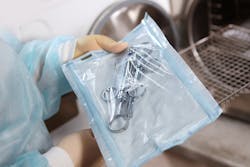Chemical indicators: A must for proper sterilization
Editor's note: This article first appeared in the March 2021 issue of RDH magazine titled "Your canary in the sterilization process coal mine."
When it comes to providing the highest quality oral care and promoting infection control in the practice, the sterilization of all dental instruments is paramount.1 All sterilization processes should consist of three types of monitoring to ensure the procedure has been fully carried out: mechanical, biological, and chemical. Mechanical monitoring indicates that the machinery is operating at the correct temperature, for the specified time, at the proper pressure. This information should be recorded for every load of instruments sterilized.2 Despite the quick turnover of dental instruments, biological monitoring or spore testing is only required weekly, but may be required more frequently if you are accredited through the Joint Commission or are sterilizing an implantable device.3 Chemical indicators are essential because they make it possible for us to confirm that instruments have gone through the sterilization process between biological monitoring. But do all dental professionals fully understand them and give them the attention they deserve?
Chemical indicators
Instrument packaging should have two types of chemical indicators: external and internal. Indicators on the outside of the packaging demonstrate whether instruments have been exposed to heat or not, whereas those inside indicate whether the sterilizing agent—steam, in many cases—penetrated the material to reach the instruments. The indicators change color when the steam or chemicals used reach specific parameters, verifying the validity of the sterilization process.
There are other variations in both types of indicator to take into consideration. For example, a single-parameter internal chemical indicator will give feedback regarding a specific aspect of sterilization. It could indicate a measurement of time or temperature, but not both. A multiparameter internal chemical indicator can react to two or more of those set parameters. Multiparameter indicators are far more reliable, but they’re only available for steam sterilizers.
Also available are dual indicators which assess both external and internal areas.4 These operate without a monitoring strip, but to work properly, the correct pouches need to be purchased and used. For a built-in indicator, placing the strip inside the cassette can serve the same purpose, but a type 5 integrator and a single parameter indicator tape are needed if the cassette is wrapped in woven fabric.5
By using pouches/bags with built-in internal and external indicators, the need to insert another indicator strip into the cassette is all but eliminated; however, it is recommended that those built-in indicators are multiparameter, which only work with steam, as opposed to those that can only measure one parameter.
How do we use them?
Different types (formerly referred to as “classes”) of chemical indicators are used for particular processes.6 Type 1 indicators, or process indicators, are generally used externally to differentiate between processed and unprocessed items. A specific test indicator (type 2) evaluates performance and determines if air removal was correctly completed in a prevacuum sterilizer. Type 3 indicators, such as single-variable indicators, are used to measure temperature or time and test exposure in specific locations.
Type 4, or multivariable indicators, can react to more than one parameter as specified by the manufacturer. Type 5 and type 6 indicators can react to all critical parameters in the sterilization process and are used internally.
The parameters measured throughout the sterilization process include time, temperature, and steam presence. By determining the levels of each of these measurable factors, chemical indicators give guidance as to whether the process was complete.
Chemical indicators are a vital component in the sterilization of dental tools. When used in conjunction with spore testing and physical monitoring, they can help practices maintain high standards of sterilization and reduce the risk of infection.
Why do we use them?
Chemical indicators are an essential part of ensuring that tools have undergone the sterilization process for every patient. If sterilization wasn’t successful, there’s a risk of cross-contamination or infection. In the simplest terms, chemical indicators help ensure our patients’ safety.
They use sensitive, color-changing chemicals to indicate whether or not physical conditions like time, pressure, and temperature have met the required amounts necessary to sterilize the equipment. They are not proof of successful sterilization, but rather a detection process that can highlight procedural errors or equipment malfunctions. Spore tests are the only true way to confirm that the process has been successfully completed.
Sterilization failures can happen thanks to faulty packaging, overloading the machinery, or various other malfunctions of the sterilizer itself. Although chemical indicators are not enough on their own to determine whether sterilization has occurred, when used along with physical monitors and regular spore testing, they can be a vital tool for quality assurance.4
When do we use them?
The use of chemical indicators will depend on the sterilization process and the tools. When sterilization of equipment is required, a chemical indicator should always be used. In the case of critical instruments, sterilization should take place after every use. This includes any tools in contact with the bloodstream, and tools working in and around bone and soft tissues within the mouth. Instruments that maintain contact with mucous membranes or nonintact skin should also be processed after every use. Noncritical instruments that only come into contact with skin will only require low-level disinfection between patients due to the reduced risk of transmission. The instructions for use will be a great guide.
Chemical indicators should be used in conjunction with biological indicators to monitor the proper functioning of sterilization cycles, and thus, should be used during every cycle. It should also be noted that placing a type 5 indicator into every load by itself will help ensure that all parameters are being met in between spore tests. Since patient safety is of the utmost importance, following proper sterilization processes and protocols on all equipment in the dental practice is essential.
REFERENCES
- Rani L, Pradeep. Sterilization protocols in dentistry—A review. J Pharm Sci Res. 2016;8(6):558-564. Accessed December 15, 2020. https://search.proquest.com/openview/9cf7f1ff907efe2bc28d950e7520b6c4/1?pq-origsite=gscholar&cbl=54977
- Sterilization: Monitoring. Centers for Disease Control and Prevention [Oral Health section]. Accessed December 15, 2020. https://www.cdc.gov/oralhealth/infectioncontrol/faqs/monitoring.html
- Huber MA. Biological indicators [continuing education course]. DentalCare.com. Accessed December 15, 2020. https://www.dentalcare.com/en-us/professional-education/ce-courses/ce474/biological-indicators
- OSAP: the safest dental visit. Accessed December 17, 2020. https://www.osap.org
- Galloro G. Setting the record straight on infection prevention and control. The facts about steam chemical indicators. CDHO. Accessed December 15, 2020. https://www.cdho.org/docs/default-source/pdfs/reference/guidelines/steam-chemical-indicators.pdf
- 6 ISO types of chemical indicators for steam sterilization. Steris Life Sciences. Accessed December 15, 2020. https://www.sterislifesciences.com/resources/documents/article-reprints/chemical-indicators-for-steam-sterilization
About the Author
Michelle Strange, RDH
Michelle Strange, RDH, is a dedicated dental hygienist and educator passionate about infection control and patient safety. With over 20 years of experience in clinical practice, Michelle is committed to sharing evidence-based solutions to improve dental care outcomes.


